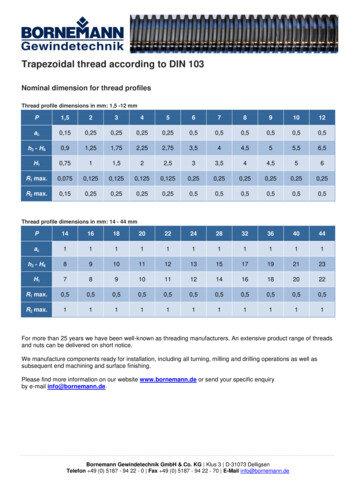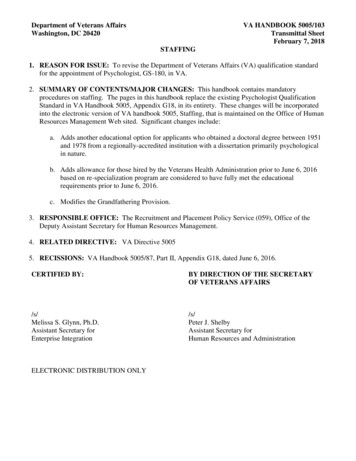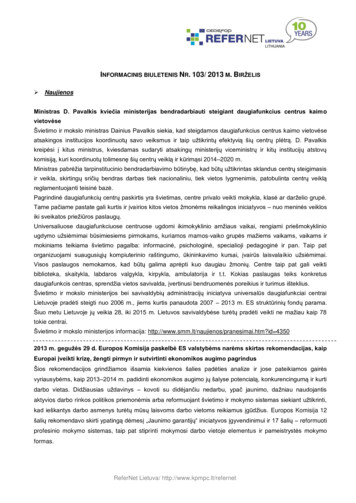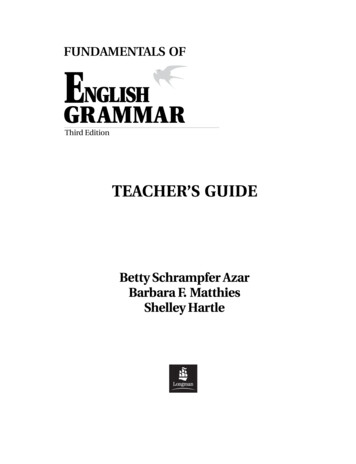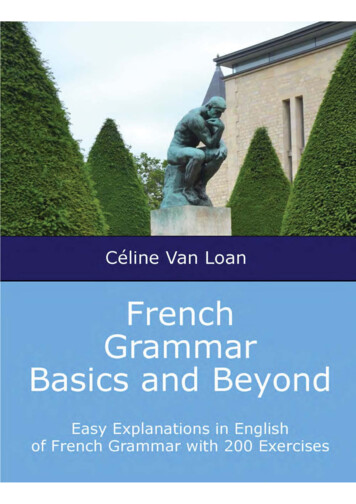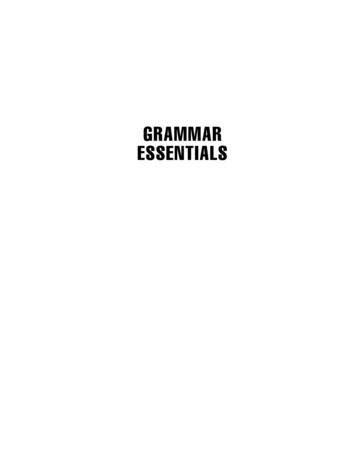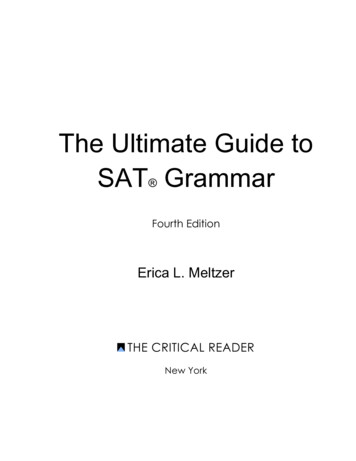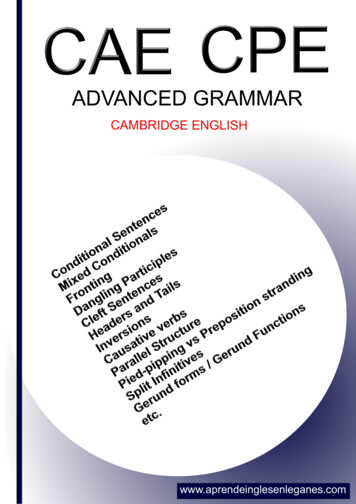
Transcription
ADVANCED GRAMMARCAMBRIDGE ENGLISHwww.aprendeinglesenleganes.com
While every precaution has been taken in the preparation of thisbook, the publisher assumes no responsibility for errors oromissions, or for damages resulting from the use of theinformation contained herein.CAE CPE ADVANCED GRAMMARFirst edition. July 19, 2016.www.aprendeinglesenleganes.com
5. 6. 7. 8. 9. 10. 11. 12. 13. 14. 15. 16. 17. 18. 19. 20. 21. 22. 23. 24. 25. 26. 27. 28. 29. 30. 31. 32. 33. 34. 35. 36. 37. 38. 39. 40. 41. 42. 43. 44. 45. 2ABSENCE OF vs LACK OFACROSS vs OVER vs THROUGHADJECTIVES POSITION AFTER SUCH vs SO , TOO, etcADJECTIVES PREPOSITIONSALL vs WHOLE vs EVERY vs ENTIREALMOST VS NEARLYAND vs & (AMPERSAND)ANNOYED BY / WITH/ ABOUT / AT / THATAPART FROM vs EXCEPT / EXCEPT FORARRANGE vs SCHEDULEAS . . . AS vs SO . . . ASAS IF / AS THOUGHAS LONG AS vs SO LONG ASATMOSPHERE vs ENVIRONMENT vs AMBIENCEATTEND vs ATTEND TOBE RESPONSIBLE TO vs BE RESPONSIBLE FORBECAUSE OF vs DUE TOBEFORE vs UNTILBELOW vs BENEATH vs UNDER vs UNDERNEATHBE ON FOR SOMETHING vs BE UP TO SOMETHINGBE UP FOR SOMETHING vs BE IN FOR SOMETHINGCANNOT vs CAN NOTCAUSATIVE VERBS (LET, MAKE, HAVE, GET, HELP)CLEFT SENTENCESCONCERN IN / CONCERN ABOUT /BY/OVER /CONCERN WITHCONDITIONALS (IF CLAUSES)CONDITIONALS – MIXED CONDITIONALSDANGLING PARTICIPLESDEFINITE ARTICLE: THEDID NOT USE TO (DIDN’T USE TO) vs USED NOT TO (USEDN’T)DO IT vs DO SOFALL DOWN vs FALL OVERFOR NOW / FOR THE TIME BEING / FO THE MOMENTFRONTINGGERUND FORMS / GERUND FUNCTIONSGO ON TO DO SOMETHING / GO ON TO SOMETHINGGO ON DOING SOMETHINGHARD vs HARSH vs TOUGH vs ROUGHHAVE AN INTEREST vs TAKE AN INTERESTHEADERS and TAILSI DIDN’T THINK OF THAT vs I HADN’T THOUGH OF THATIF ONLY vs I WISHINVERSIONS IN ENGLISHwww.aprendeinglesenleganes.com
46. 47. 48. 49. 50. 51. 52. 53. 54. 55. 56. 57. 58. 59. 60. 61. 62. 63. 64. 65. 66. 67. 68. 69. 70. 71. 72. 73. 74. 75. 76. 77. 78. 79. 80. 81. 82. 83. 84. 85. 3IT , SHE or HE WHEN REFERRING TO ANIMALS?IT vs THIS.IT’S TIME vs IT’S ABOUT/ HIGH TIMELAST vs LATESTLET ALONE / MUCH LESS /STILL LESS / EVEN LESS / NOT TO MENTION /MADE (out) OF vs MADE FROM vs MADE WITHMAIN vs PRINCIPALMANDATORY vs COMPULSORY vs OBLIGATORYMAY AS WELL vs MIGHT AS WELLMAYBE vs PERHAPS vs PROBABLYMIGHT HAVE vs MUST HAVEMOST vs MOST OF THEMUST vs OUGHT vs SHOULDNEED vs DARE AS SEMI-MODALS (Modal phrases)NEXT vs FOLLOWING – THE NEXT vs NEXTTHE FOLLOWING vs FOLLOWINGNO MORE THAN vs NOT MORE THANNOWHERE NEAR vs NOT NEARLYON vs ABOUTONLY vs EXCEPT THATONTO vs ON TOOPPORTUNITY vs CHANCEOPTION vs ALTERNATIVEPARALLEL STRUCTUREPASSIVE VOICEPIED-PIPING vs PREPOSITION STRANDINGPLURAL NOUNS (IRREGULAR)PUT ONE’S HEART (AND SOUL) IN /INTO SOMETHINGSET ONE’S HEART (MIND) ON SOMETHINGREDUCED RELATIVE CLAUSESREGRET DOING vs REGRET HAVING DONESEE SOMEBODY DO SOMETHING vsSEE SOMEBODY DOING SOMETHINGSEEM LIKE vs LOOK LIKE vs FEEL LIKE vs SOUND LIKESENSITIVE TO vs SENSITIVE ABOUTSET PHRASES vs VARIABLE PHRASESSHORT TIME vs LITTLE TIMESHOULD vs MUST vs OUGHT TOSINCE / SINCE THEN / EVER SINCESO vs TOOSO LONG / SO FAR – ONLY SO MUCH/ ONLY SO MANYSOME vs MANYSOON vs EARLYwww.aprendeinglesenleganes.com
86. 87. 88. 89. 90. 91. 92. 93. 94. 95. 96. 97. 98. 99. 100.101.102.103.4SPLIT INFINITIVESSUBSTITUTE FOR vs REPLACE WITHSURE IF vs SURE THATTHAT vs WHICHTHE FORMER vs THE LATTERTHINK OF SOMETHING vs THINK SOMETHING UPTO DO vs FOR DOINGTRY AND vs TRY TOUNTIL THEN vs BY THEN / UNTIL THAT TIME vs BY THAT TIMEUSED TO DO vs BE USED TO DOINGUSUAL vs USUALLYWHETHER vs IFWHICH vs WHOSEWHICHEVER vs WHATEVERWHO vs THATWILL vs SHALLWOULD vs USED TOYOU vs YOUR with gerundwww.aprendeinglesenleganes.com
ABSENCE OF vs LACK OFLACK OF something : It implies a judgement - that the thing lacking is in somesense required.ABSENCE OF something : It merely reports a state of affairs - the negation of apresence (no judgement is implied).An ABSENCE OF something can be a good thing.A LACK OF something implies that something that is desired is in short supply.'X is absent' 'X is not here''X is lacking' 'X is not here and X is desired' or 'X is not here in sufficientquantity, and X (in sufficient quantity) is desired'Examples : There was a complete lack of trust between them.(trust is something desired or required – they need more of it) I closed the door to my room and silently rejoiced at the complete absenceof noise for the first time that day.(We are just stating a fact.The absence of noise is something that we enjoyin this case- We don’t want more noise)5www.aprendeinglesenleganes.com
ACROSS vs OVER vs THROUGHACROSS is used as a preposition (prep) and an adverb (adv).Across means on the other side of something, or from one side to the other ofsomething which has sides or limits such as a city, road or river: Across the room, she could see some old friends. [PREP] When I reached the river, I simply swam across. [ADV] She walked across the road. [ADV]Across is used when something touches or stretches from one side to another: There is a beautiful old bridge across the river. She divided the page by drawing a red line across it.Especially in American English, across from is used to refer to people or objectsbeing ‘opposite’ or ‘on the other side’: The pharmacy is across from the Town Hall./ Helen’s office is just across from mine.ACROSS Happening at the same time in many places (a city, country, company.) She’s opened coffee shops across the city and they’re very successful. The royal wedding was celebrated across the nation.OVER is used as a preposition /adverb to refer to something at a higher positionthan something else, sometimes involving movement from one side to another: From the castle tower, you can see [PREP]over the whole city. Suddenly a plane flew [ADV]over and dropped hundreds of leaflets.Especially when we use them as adverbs, over can mean the same as across:We walked (over / across) to the shop – the shop is on the other side of the road)I was going across / over to say hello when I realised that I couldn’t rememberhis name. ( meaning ‘to the other side of the street or room’)ACROSS vs THROUGHWhen we talk about movement from one side to another but ‘in something’, suchas long grass or a forest, we use through instead of across:I love walking through the forest. (through stresses being in the forest as I walk)Not: I love walking across the forest.Periods of time from start to finish (US) : Monday through FridayPeriods of time from start to finish (UK) : From Monday to FridayOVER is used to refer to periods of time from start to finish when a number isspecified (of days, weeks, etc.): We don’t use THROUGH/this way.Over the last few days, I have been thinking a lot about quitting my job.When moving from one side to another while surrounded by something, we usethrough not across: We cycled through the woods. Not: We cycled across the woods.ACROSS extending or moving from one side to another.The papers were spread across the table. / Not: The papers were spread on the table.6www.aprendeinglesenleganes.com
ADJECTIVES POSITION AFTER SUCH vs SO , TOO, etcSuch , so and too are degree quantifiers.Such goes before Noun Phrases and so goes before adjectives and adverbs;they're alternants. She is so good [that she can make anything]. She is so good at carpentry [that she can make anything]. She is so good as a carpenter [that she can make anything]. She is so good a carpenter [that she can make anything]. She is such a good carpenter [that she can make anything].SUCH A ADJ NOUN --- SO ADJ A NOUNHowever, they usually come equipped with a that clause to show just what thestandard is for the comparison. That's the normal use.It's also common in some idiolects to use emphasized so or such -- without a thatclause -- as a general emotional intensifier, like very or extremely, but withemotional expression. This can be overdone, and is often satirized, especiallywhen attributed to women. But this is conversational only, not written. She's so intelligent. She's extremely intelligent (and that impresses me).He's such a cute little boy. He's a very cute little boy (and I find thatendearing).Adjectives : position after as, how, so, too, etc.After as, how, so, too and this/that meaning so, adjectives go before a / an.This structure is common in a formal style.As / how / so / too / this / that adjective (a / an) noun I have as good a car as you. How good a fighter is he? I have never seen so beautiful a girl. That’s not so great an option. He is too nice a girl to refuse. I have too painful a headache to go clubbing tonight. I wouldn’t buy that expensive a car. It was so cold a day that I couldn’t go running.The structure is not possible without a / an.I like your sister - she's so beautiful. (NOT I like your so beautiful sister.)Those guys are too stubborn to accept.(NOT They are too stubborn guys to accept.)7www.aprendeinglesenleganes.com
ADJECTIVES leganes.comXX
ALL vs WHOLE vs EVERY vs ENTIRECommon Errors in English: All, Whole, EveryAll and whole are determiners and we use them before nouns and with otherdeterminers to refer to a total number or complete set of things in a group.All my friends came to see me. (all determiner noun)My whole group of friends came to see me. ( determiner whole noun )Don’t say: “I invited all the class.”Say: “I invited the entire class.” (more formal)Or: “I invited the whole class.” (more informal)EVERYUse every with singular, countable nouns: I exercise every day.Every student in the class has a computer.Every necklace in this store costs more than 1,000.ALLUse all with plural countable nouns OR with uncountable nouns to mean 100% of many things: All of this equipment is new. many pieces of equipmentAll the students in the class have computers.All the necklaces in this store are expensive.WHOLE / ENTIREUse whole or entire with uncountable or singular countable nouns to mean 100% of one thing: I ate the whole pizza. 100% of one pizza.I finished reading the entire book in three days. 100% of one book.ALL vs. WHOLEHere are more examples that show the difference between all and whole: 9I ate the whole cake. 100% of one cake.I ate all the cakes. 100% of many cakesThe whole apple is rotten. 100% of one apple.All the fruit is rotten. 100% of many apples, bananas, grapes, etc.www.aprendeinglesenleganes.com
ALMOST VS NEARLYALMOST means practically the same thing as NEARLY, and in most casesthey are interchangeable. Don’t give up! You’re almost there. It’s time for bed. It’s nearly 10 o’clock. Their CD has sold almost 90,000 copies in the last week. Nearly all my friends were in the photograph.We also use ALMOST and NEARLY with extreme adjectives such as perfect,impossible or frozen: That guy is almost impossible. The chicken is still nearly frozen. I thought you’d taken it out of thefreezer.ALMOST means very nearly but not exactly or entirely.Nearly means almost but not quite, but its primary meaning has more to do withproximity, i.e., in a close manner or relationship.ALMOST is typically followed by adverbs.Examples: almost always, almost certainlyNEARLY is usually followed by numbers.Example: Nearly 72,000 people attended the Texans playoff game SundayNEARLY is often used in the following construction: not nearly as [adjective]Example: He’s not nearly as smart as he thinks he is.Here’s a suggestion: If you have used a lot of “almost” words on a single page,you can change things up a bit by using “nearly” a few of those times.We use ALMOST (but not nearly) to soften statements: I almost wish I hadn’t offered to pay his fine.We use ALMOST before any and before negative words such as no, none,never, nobody, nothing. We don’t use nearly in this way:[describing computer software which traces the history of towns] Using this software, you can find the history of almost any building. They’ve almost no confidence that they can use the new phone properly. She almost never raises her voice.Not: She nearly never raises her voice.10www.aprendeinglesenleganes.com
AND vs & (Ampersand)SMS and Twitter aside, the ampersand in standard English usage and compositionshould follow these rules:F. Business names. Using the ampersand as part of a business name is appropriate.An example of this is Dun & Bradstreet. Also, many attorneys with multiplepartners connect their names with an ampersand.G. Addresses. Letters addressed to two people. For example, you may address yourenvelope like this: "Mr. & Mrs. Smith."H. Citing sources. When more than one author appears in a citation, use anampersand to connect the last two (Nevid, Rathus, & Greene, 2008). Keep inmind that some styles such as APA use the ampersand here while others such asChicago write out the word "and." If you have questions about this, be sure toconsult your appropriate style handbook.I. Screenplay. When more than one name is attributed to a screenplay, theampersand is used to connect the final two names.J. Et cetera. Sometimes et cetera is abbreviated using an ampersand rather thanthe beginning "et." In other words, English usage permits either &c. or etc.K. Programming and special characters. Most programming languages use theampersand for concatenation, comparison operations, and other purposes.Programs such as Microsoft Excel also have special uses for the ampersand.Except for these uses, always use "and."11www.aprendeinglesenleganes.com
ANNOYED BY / WITH/ ABOUT / AT / THATANNOYED ABOUT/AT /BY SOMETHING / DOING SOMETHINGI bet she was annoyed at having to write it out
4 www.aprendeinglesenleganes.com 86. SPLIT INFINITIVES 87. SUBSTITUTE FOR vs REPLACE WITH 88. SURE IF vs SURE THAT 89. THAT vs WHICH 90. THE FORMER vs THE LATTER
